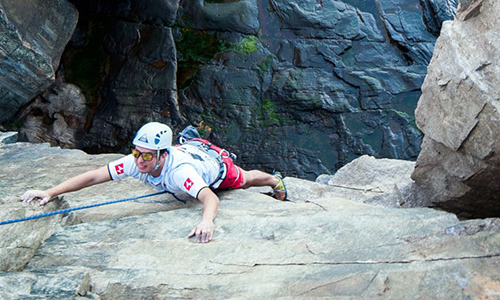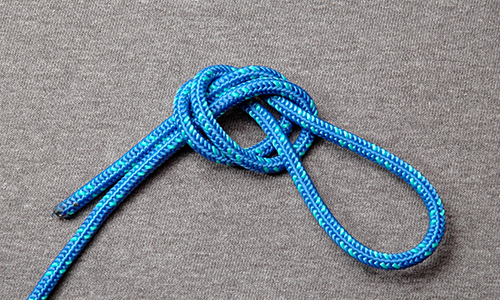First Know The Type of Knots Before You Start The Fun of Rock Climbing
Author

Chris shares his passion for cycling, hiking, skiing, and climbing from Buxton, in the Peak District. As a blogger for Outdoor Look, Chris shares outdoor tips and indoor tricks to help you get the most out of your time spent outside. When he's not out adventuring he's making videos or trying to keep up with his 4-year-old son.
 Rock climbing wouldn’t have existed if the whole concept of tying knots didn’t exist. Even if it existed, the mortality rate would have been higher due to the lack of safety measures being taken. Knowing the type of knots is an essential life saving skill which is mandatory to learn, irrespective of the climbing level which you are currently in.
Rock climbing wouldn’t have existed if the whole concept of tying knots didn’t exist. Even if it existed, the mortality rate would have been higher due to the lack of safety measures being taken. Knowing the type of knots is an essential life saving skill which is mandatory to learn, irrespective of the climbing level which you are currently in.
Every climber should be well equipped with knots to that level that he/she should be able to tie the figure eight-tie in knot even in their sleeps. It should be at the top of the list of knots to be learned. After that knot is mastered, then you can go through the list mentioned below of the knots to be mastered:
Figure Eight Tie-in knot with Double Stopper: This is the first climbing knot to be learned. You will use it every time you climb with a rope. So, it is worth practising this even with your eyes closed. This version has a double stopper at the end to make it more secure.
Note: It is very important to start this knot in the right place on the rope. Otherwise you will be left with not enough rope to tie the knot or extra rope will be left hanging.
Clove Hitch: This is the most versatile way of climbing knots which is usually tied in the middle of the rope.
Note: You simply need to loosen the knot in order to adjust the position.
Figure Eight on a Bit: This is a quick, easy and secure way to make a loop in the middle of the rope. This is used to secure yourself to an anchor or to create a loop to attach gear to if it becomes necessary.
Note: Once the rope is tied, it can be difficult to readjust the position. So, you have to take care of the length which needs to be tied.
Water Knot: This is also known as ring bend. Since this piece of rope is incredibly easy to tie, people use them to attach two pieces of rope instead of double fisherman’s knot. This is easier to untie than any other form of knot.
Note: They can loosen over time, so make sure that you check them.
Barrel Knot: This is a knot which is similar to the stopper knot which is used in a figure eight tie-in knot. It has one extra loop than a double overhand. This makes it more secure when used on its
Note: Secure a stopper at the end of the rope when repelling or belaying.
 Prusik Knot: These knots are extremely useful in rescue situations and are often used in pairs. These are fiction hitches which grip onto the rope when weight is applied.
Prusik Knot: These knots are extremely useful in rescue situations and are often used in pairs. These are fiction hitches which grip onto the rope when weight is applied.
Note: They are also used if you take a fall on an overhang. It is used in pairs. One is weighted while the other is moved up the rope, switching between the two.
Double Fisherman’s Bend: They are used to attach the ends of two ropes. This is a combination of two double overhand knots.
Note: Once weight has been put through the knot, it can be really difficult to untie which can have both positive and negative effects.
So, after you have gained enough information about knots, next step is climbing. Bang on!
Author

Chris shares his passion for cycling, hiking, skiing, and climbing from Buxton, in the Peak District. As a blogger for Outdoor Look, Chris shares outdoor tips and indoor tricks to help you get the most out of your time spent outside. When he's not out adventuring he's making videos or trying to keep up with his 4-year-old son.
- Speed Up Your Post-Hike Recovery with These 6 Essential Tips
- Cycling through Tranquil Roads and Coastal Views on the Isle of Wight
- The Essential Guide to Hiking Safety: 5 Tips Every Hiker Should Know
- Run Smart, Run Strong: Your Guide to Injury-Free Running
- Embrace Biking: Essential Tips for Beginners
Categories
- Sport (28)
- Product Reviews (3)
- Team Outdoor Look (7)
- Mike Wild (2)
- Mike Payton (2)
- Suse Hammond-Pears (3)
- Snowboarding (12)
- Latest Offers (105)
- Shop Talk (1)
- Competitions (7)
- Walking (413)
- Lifestyle Fashion (8)
- Travel (86)
- Kit Guides (176)
- Workwear Clothing (6)
- Safety Workwear (4)
- Health/Fitness (289)
- Skiing (91)
- Great Outdoors (1316)
- Cycling (92)
- January 2025
- December 2024
- November 2024
- October 2024
- September 2024
- August 2024
- July 2024
- June 2024
- May 2024
- April 2024
- March 2024
- February 2024
- January 2024
- December 2023
- November 2023
- October 2023
- September 2023
- August 2023
- July 2023
- June 2023
- May 2023
- April 2023
- March 2023
- February 2023
- January 2023
- December 2022
- November 2022
- October 2022
- September 2022
- August 2022
- July 2022
- June 2022
- May 2022
- April 2022
- March 2022
- February 2022
- January 2022
- December 2021
- November 2021
- October 2021
- September 2021
- August 2021
- July 2021
- June 2021
- May 2021
- April 2021
- March 2021
- February 2021
- January 2021
- December 2020
- November 2020
- October 2020
- September 2020
- August 2020
- July 2020
- June 2020
- May 2020
- April 2020
- March 2020
- February 2020
- January 2020
- December 2019
- November 2019
- October 2019
- September 2019
- August 2019
- July 2019
- June 2019
- May 2019
- April 2019
- March 2019
- February 2019
- January 2019
- December 2018
- November 2018
- October 2018
- September 2018
- August 2018
- July 2018
- June 2018
- May 2018
- April 2018
- March 2018
- February 2018
- January 2018
- December 2017
- November 2017
- October 2017
- September 2017
- August 2017
- July 2017
- June 2017
- May 2017
- April 2017
- March 2017
- February 2017
- January 2017
- December 2016
- November 2016
- October 2016
- September 2016
- August 2016
- July 2016
- June 2016
- May 2016
- April 2016
- March 2016
- February 2016
- January 2016
- December 2015
- November 2015
- October 2015
- September 2015
- August 2015
- July 2015
- June 2015
- May 2015
- April 2015
- March 2015
- February 2015
- January 2015
- December 2014
- November 2014
- October 2014
- September 2014
- August 2014
- July 2014
- June 2014
- May 2014
- April 2014
- March 2014
- February 2014
- January 2014
- December 2013
- November 2013
- October 2013
- September 2013
- August 2013
- July 2013
- June 2013
- May 2013
- April 2013
- March 2013
- February 2013
- January 2013
- December 2012
- November 2012
- October 2012
- September 2012
- August 2012
- July 2012
- June 2012
- May 2012
- April 2012
- March 2012
- February 2012
- January 2012
- December 2011
- November 2011
- October 2011
- September 2011
- August 2011
- May 2010
- April 2010
- March 2010
- February 2010
- January 2010
- November 2009
- October 2009
- September 2009
Submit a Comment